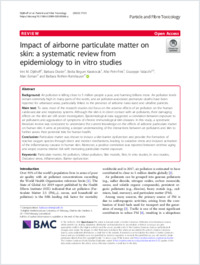Impact of airborne particulate matter on skin: a systematic review from epidemiology to in vitro studies
- Dijkhoff, Irini M. Adolphe Merkle Institute, University of Fribourg, Chemin des Verdiers 4,CH-1700 Fribourg, Switzerland
- Drasler, Barbara Adolphe Merkle Institute, University of Fribourg, Chemin des Verdiers 4,CH-1700 Fribourg, Switzerland
- Karakocak, Bedia Begum Adolphe Merkle Institute, University of Fribourg, Chemin des Verdiers 4,CH-1700 Fribourg, Switzerland
- Petri-Fink, Alke Adolphe Merkle Institute, University of Fribourg, Chemin des Verdiers 4,CH-1700 Fribourg, Switzerland - Department of Chemistry, University of Fribourg, Switzerland
- Valacchi, Giuseppe Department of Biomedical and Specialist Surgical Sciences, University of Ferrara, Ferrara, Italy -
- Eeman, Marc Dow Silicones Belgium, Seneffe, Belgium
- Rothen-Rutishauser, Barbara Adolphe Merkle Institute, University of Fribourg, Chemin des Verdiers 4,CH-1700 Fribourg, Switzerland
-
25.07.2020
Published in:
- Particle and Fibre Toxicology. - 2020, vol. 17, no. 1, p. 35
English
Air pollution is killing close to 5 million people a year, and harming billions more. Air pollution levels remain extremely high in many parts of the world, and air pollution- associated premature deaths have been reported for urbanized areas, particularly linked to the presence of airborne nano-sized and ultrafine particles.Main text: To date, most of the research studies did focus on the adverse effects of air pollution on the human cardiovascular and respiratory systems. Although the skin is in direct contact with air pollutants, their damaging effects on the skin are still under investigation. Epidemiological data suggested a correlation between exposure to air pollutants and aggravation of symptoms of chronic immunological skin diseases. In this study, a systematic literature review was conducted to understand the current knowledge on the effects of airborne particulate matter on human skin. It aims at providing a deeper understanding of the interactions between air pollutants and skin to further assess their potential risks for human health.Conclusion: Particulate matter was shown to induce a skin barrier dysfunction and provoke the formation of reactive oxygen species through direct and indirect mechanisms, leading to oxidative stress and induced activation of the inflammatory cascade in human skin. Moreover, a positive correlation was reported between extrinsic aging and atopic eczema relative risk with increasing particulate matter exposure.
- Faculty
- Faculté des sciences et de médecine
- Department
- Département de Chimie, AMI - Bio-Nanomatériaux
- Language
-
- English
- Classification
- Biological sciences
- License
-
License undefined
- Identifiers
-
- RERO DOC 328908
- DOI 10.1186/s12989-020-00366-y
- Persistent URL
- https://folia.unifr.ch/unifr/documents/309083
Statistics
Document views: 188
File downloads:
- pdf: 290
